From incentivising airlines to securing their own pipelines, airports worldwide are coming up with innovative ways to prepare for the widespread use of SAF, finds Emma Kelly
The journey towards widespread use of sustainable aviation fuels (SAF) remains a slow but steady one. The first test flight of biofuel on a commercial aircraft was undertaken in February 2008 when a Virgin Atlantic Boeing 747 flew between London and Amsterdam using a sustainable biomass-to-liquid fuel mixed with traditional kerosene-based jet fuel. A multitude of test flights followed, resulting in the approval of SAF for use in aircraft operations in 2011. More than 450,000 commercial flights have been conducted using alternative-traditional fuel blends and more than 4.8 billion tonnes (6 billion litres) of SAF forward purchase agreements have been made, according to the Air Transport Action Group, the industry body focused on sustainability.
Many airports are prepared for the wider scale use of SAF, found the International Civil Aviation Organization. By late January 2023, some 60 airports were distributing the fuel and 39.9 billion litres of SAF were under offtake agreements.
Airports do not generally buy aviation fuel, but they play a vital role, nonetheless. Jonathan Wood, vice-president Europe, renewable aviation, at SAF producer Neste, said: “Airports are an important part of the aviation fuel supply chain as they facilitate the fuel uplift by airlines through the airports’ fuel infrastructure.” Neste’s MY SAF is made from sustainably sourced, 100% renewable waste and residue raw materials, including used cooking oil and animal fat waste.
Neste’s current annual SAF production capacity is around 100,000 tonnes, but it is looking to increase this to 1.5 million tonnes (1.875 billion litres) by the end of this year following expansion of its Singapore refinery and modification of its Rotterdam refinery, while global annual production capacity will rise to 2.2 million tonnes by 2026.
Airports can play an important role in supporting required investments in SAF production
The benefits of SAF
A major SAF advantage is that it is drop-in fuel, capable of being used with conventional jet fuel and via existing fuel infrastructure, with no additional investment needed. SAF is currently certified for use blended up to 50% with conventional jet fuel. “SAF is blended before being transported into the airport’s fuel infrastructure as a ready to use blended jet fuel and supplied to the airport,” explained Neste’s Wood.
As a result, there are no major challenges for airports in supporting SAF operations, according to Wood. Airports do have a major role to play, however, in increasing usage and ultimately production. “The challenge is that SAF is more expensive than conventional jet fuel and it is not easy for airlines operating in a competitive market to commit to increasing use of SAF if their competitors are not required to do the same. Airports can play an important role in supporting required investments in SAF production,” Wood said.
It points, for example, to airports taking an active role in increasing awareness of SAF and advocating policies, such as SAF blending mandates, that provide demand certainty for investment in SAF production. They can also help mitigate the cost difference by creating incentives for airline SAF use, as implemented by Amsterdam Schiphol and London/Heathrow, for example.

Its annual SAF production capacity is around 100,000 tonnes, but Neste aims to increase this to 1.5 million tonnes by the end of 2023
Close collaboration
Fuel supplier Air bp is working closely with customers to drive SAF supply as it aims for a 20% share of global sustainable aviation fuel sales by 2030. The company currently supplies SAF to customers at over 30 locations. It can deliver SAF across Europe, including Sweden, Norway, France, the Netherlands, Germany and the UK, and is working to expand its footprint, including the US. Air bp supplies SAF from its refineries in Lingen, Germany, and Castellon, Spain, in addition to sourcing SAF from third-parties, and is investing in three bio-plants and converting up to two refineries to bio-refineries to meet demand.
“We’ve been taking steps to help contribute to shaping a lower carbon aviation industry for over a decade,” said Andreea Moyes, global head of sustainability, pointing to its involvement in the first biofuel flight in 2008 and the first SAF commercial supply through an existing hydrant fuelling system, at Oslo Airport in 2016.
The main challenges for widescale SAF adoption relate to price and technologies. “Production of SAF is limited, as the higher cost compared to conventional jet fuel is preventing wider uptake,” said Moyes, with the “neat” element of SAF typically three to six times more expensive than conventional jet fuel. A reduction in cost is key to greater use.
“Air bp is working with customers to create more demand in the short term, which will lead to more production and hopefully lower costs,” Moyes added. While airline initiatives, including giving customers the option to fund the use of SAF to reduce emissions, are positive, policy incentives from governments and other stakeholders are needed, according to Moyes. Investment is needed in advanced technologies to process SAF feedstocks more efficiently at greater scale, as is investment in sustainable and scalable feedstock options.
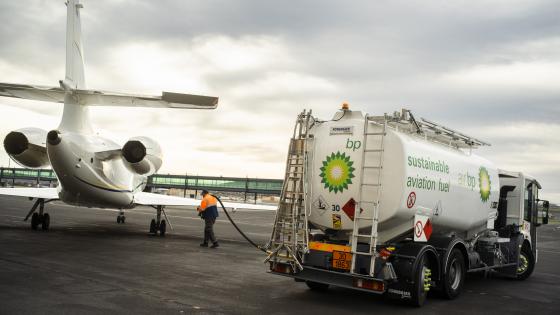
Air bp supplies SAF from its refineries in Lingen, Germany, and Castellon, Spain
Storing SAF at the airport
From an infrastructure point of view, no changes are required for SAF, but one aspect for airports to consider is how SAF will be supplied, said Moyes, with three options available. Firstly, some airports prefer to keep the SAF blend segregated in tanks and fuelling vehicles separatedfrom traditional jet fuel ones. “This can make the delivery of SAF more transparent, but may increase costs or complexity for airports that don’t have separate infrastructure available,”Moyes pointed out.
Secondly, SAF can be stored using mass balance, whereby it is co-mingled in the same tanks as traditional jet fuel. “As it is typically delivered at a 30-45% blend to airports, the SAF is diluted further in these storage tanks before it is used to refuel aircraft. This provides a more efficient means of supply,” Moyes explained. “Although by co-mingling the SAF, all customers refuelling at the airport may receive a proportion of sustainable feedstocks, only those purchasing the SAF can claim the associated sustainability benefits. This is backed-up by the independent certification that accompanies the purchase of SAF.”
Thirdly, a customer can choose to use a ‘book and claim’ system, which provides access to SAF carbon reductions without being physically connected to the supply site. “The programme enables bp to deliver the SAF into the supply chain at one airport location and ‘book’ the carbon reduction associated with it into a registry. The customer at another location can ‘claim’ those carbon reductions by purchasing their traditional jet fuel along with the benefits of the lifecycle carbon reductions that have been registered in that registry,” explained Moyes, noting that the registry is independently managed to ensure credibility. “Book and claim helps provide wider market access and builds demand for the product, which in turn will help reduce the cost.”
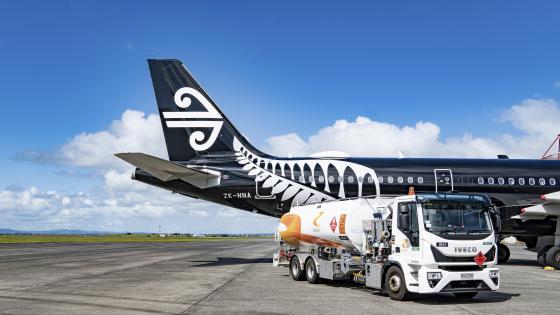
Air New Zealand welcomed its first shipment of Neste MY Sustainable Aviation Fuel in autumn 2022
Spurring each other on
Airports worldwide are not only supporting SAF operations, but actively promoting its use and investing in projects. San Francisco International Airport (SFO) leads the world in SAF deliveries, with six million gallons in the last fiscal year, accounting for 6% of all fuel, and expecting to double this in 2023.
SFO has been at the forefront of SAF developments since 2017 when it created a coalition of 150 airlines, fuel providers and other organisations to work collaboratively to expand the development and use of SAF. Multiple SAF test flights followed from SFO, but supply chain issues hampered furthered progress, resulting in SFO bringing together ten partner airlines and fuel producers to study the logistics, supply chain and financing issues.
“Very little was required for airport infrastructure, so our focus was further upstream in the supply chain,” explained Erin Cooke, director of sustainability at SFO. “Our SAF working group led advocacy efforts with agencies in the State of California to create an incentive for fuel suppliers to deliver SAF directly into our airport via existing jet fuel pipeline infrastructure. This incentive [introduced in January 2019] levelled the playing field between conventional fossil-based aviation fuel and a sustainable alternative, making California the most competitive market for SAF,” said Cooke. Advocating for nationwide legislation has followed. “The good news is that the interest is there,” she added.
SFO originally aimed for 5% of its operations using SAF by 2025, but has increased this to 10% and is confident of reaching it. More airlines are signing on to take SAF and SFO “has truly become the SAF hub”, Cooke said.
“It’s about forming coalitions between airports, airlines, aircraft manufacturers and fuel suppliers, then leveraging that collective strength to create incentives that facilitate the broader expansion of SAF,” she concluded.
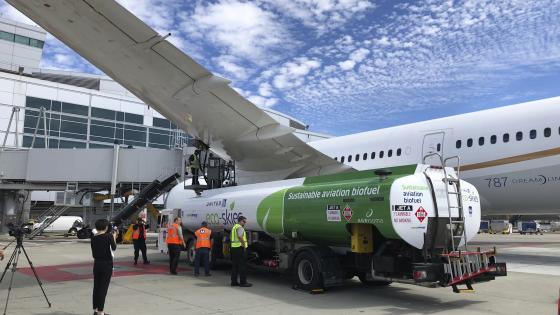
SFO has committed to reaching zero net emissions by 2030
European trailblazers
Amsterdam Schiphol Airport has also been an SAF pioneer, supplying more than 20,000 tonnes to airlines in 2022 through its existing hydrant pipelines, and aiming for 30% use by 2030.
Actions to stimulate the use of SAF and scale up production include the launch last year of a SAF incentive whereby airlines that use biofuel or synthetic fuel receive €500 and €1,000, respectively, per tonne of fuel. In addition, parent Royal Schiphol Group is investing in Europe’s first SAF refinery, to be established by SAF producer SkyNRG in 2025/26 in Defile, Groningen, with local waste flows to be used as the main raw material, producing 100,000 tonnes of SAF per year. It is also investing in synthetic kerosene start-ups, Zenid and Synkero, Denise Pronk, head of sustainability at Royal Schiphol Group, told Airports International.
London Heathrow (LHR) is another trailblazer, integrating SAF into its fuel distribution system in 2021, and last year linking airport charges with SAF use. In 2022, SAF made up 0.5% of the airport’s fuel supply – saving 55,000 tonnes of CO2. LHR is aiming for 1.5% this year and 11% by 2030. “This builds on the [UK] Government’s ambition to achieve 10% SAF by 2030 and Heathrow’s landing charges incentivising SAF use,” said an airport spokesperson.
With no infrastructure changes required, unlike liquid hydrogen and electric power, upfront infrastructure costs are minimal, “therefore, this should not be a barrier to use for interested airports,” LHR added.
LHR says airports need to work closely with their airline customers to achieve change. “We have worked with our airline partners to encourage the uptake of SAF through landing charges and encouraging SAF usage commitments. As of [end] 2022, airlines that operate over 75% of Heathrow’s schedule have committed to 10% SAF by 2030,” the London hub said.

Refuelling underway at Göteborg Landvetter Airport in Sweden
The barrier to wider SAF usage is the price and to achieve rapid scale up, LHR is calling on the UK Government to set commercial incentives for airlines to stimulate demand and foster investment, as well as an escalating mandate for SAF use by airlines in the UK.
Sweden’s Fossil-Free Sweden initiative is aiming for fossil-free domestic operations by 2030 and 2045 for all international flights from the country’s airports. Airport operator Swedavia is aiming for SAF operations to increase to 5% by 2025. A 2022 public tender organised by Swedavia saw nearly 170 tonnes of SAF refuelled – saving approximately 500 tons of CO2.
Swedavia has also established a SAF incentive programme, reimbursing up to 50% of the additional cost of SAF when airlines refuel with biofuel. “Our experience and advice to other airport operators starting their work with SAF, and the climate transition, is to support airlines with financial incentives,” Lena Wennberg, chief sustainable development officer, Swedavia, said. The airport operator also offers passengers the opportunity to contribute to sustainable air travel by purchasing SAF through the Fly Green Fund.
The UK’s Manchester Airports Group (MAG), which owns and operates Manchester, London/Stansted and East Midlands airports, is embarking on its SAF journey. It was the first UK airport group to be certified carbon neutral, in 2016, and was a founding member of the UK’s Sustainable Aviation industry coalition.
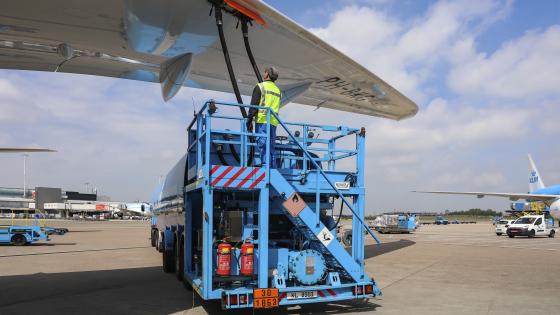
Amsterdam Airport Schiphol’s owner is investing in Europe’s first SAF refinery
It’s about forming coalitions then leveraging that collective strength to create incentives that facilitate the broader expansion of SAF

From the mid-2020s, thanks to a partnership with Fulcrum Bio Energy, Manchester Airport hopes to be the first in the UK to have a direct supply of SAF
A direct supply
In late 2021, Manchester Airport signed a memorandum of understanding with SAF producer Fulcrum Bio Energy UK for a direct SAF supply from a new bio-refinery, Northpoint in Cheshire, via existing pipelines to the airport. “This partnership has the potential to make Manchester Airport the first in the UK to have a direct supply of SAF from the mid-2020s – making the fuel available to more than 60 airlines,” said Adam Freeman, head of ESG and environmental strategy. “From the mid-2020s, 10% of the fuel used at Manchester Airport could be SAF,” he added, with Northpoint aiming to produce 100 million litres per annum. MAG is “actively engaging on SAF strategies for London Stansted and East Midlands”.
Manchester Airport has set five Jet Zero pledges to provide incentives and research support for its airline partners, including creating a financial incentive as part of its charging arrangements. It is also offering five years free of landingfees to the first airline to operatea zero-emission flight.
MAG is already looking ahead to the next developments. Late last year, Manchester announced a partnership with low carbon energy project HyNet to prepare for the future use of hydrogen. Freeman concluded: “Our partnership – connecting the airport to the HyNet network – could make the airport the first in the UK with a direct supply of hydrogen fuel.”
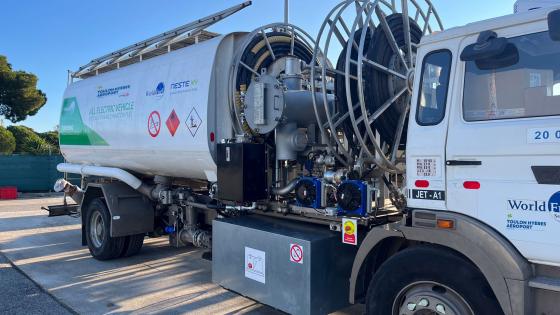
Vinci Airports, operator of Toulon Hyères Airport, and WFS, holder of the facility’s fuelling contract, recently launched a SAF service at the airport
Need to know more: What is SAF?
Sustainable Aviation Fuel (SAF) or biofuel is generally produced from biological sources, typically sustainable feedstocks such as plant matter; solid waste such as packaging, paper, textiles and food; or used cooking oil, with potential sources including forestry waste and energy crops. It can also be produced from drawing CO2 out of the atmosphere using low-carbon electricity. Nine conversion processes have been approved for producing SAF.
Chemically, SAF is almost identical to fossil fuel-based jet fuel, meaning it meets strict jet fuel specifications without requiring modifications to aircraft, engines or supply systems. SAF can currently be blended at up to 50% with traditional jet fuel, with aircraft and engine manufacturers aiming for 100%-SAF capability with next-generation products.
Clear guidance has been issued by aviation regulatory authorities on the use of SAF, said Andreea Moyes, global head of sustainability at Air bp. Before delivery to an airport, SAFis blended at up to 50% with traditional jet fuel and all quality tests are completed as per traditional jet fuel. The blend is thenre-certified as Jet A or Jet A-1.
SAF reduces CO2 emissions by approximately 80% over its lifecycle compared with fossil fuel and is a major tool for aviation to reach its net zero emissions target by 2050. The diversity of available feedstocks, a solution to volatile fuel costs and economic opportunities particularly for developing nations, are added benefits.
Production of the quantity required to make SAF commercially viable has been a stumbling block, but progress is being made. SAF production for 2022 has been estimated by IATA to be at least 300 million litres – 200% up on 2021’s 100 million litres – while others put it closer to 450 million litres. For aviation to reach its 2050 net zero emissions target, annual production capacity of 450 billion litres will be required.
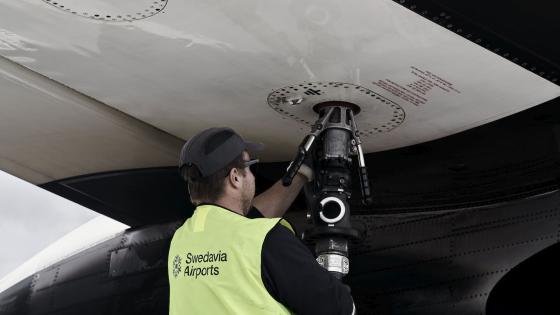
Airport operator Swedavia offers passengers the opportunity to contribute to sustainable air travel by purchasing SAF through its Fly Green Fund
